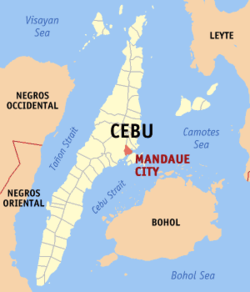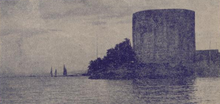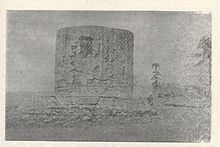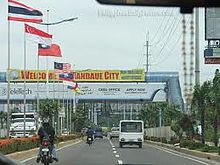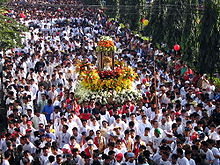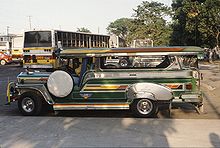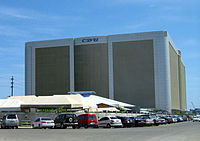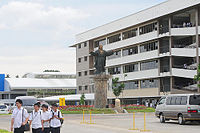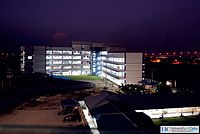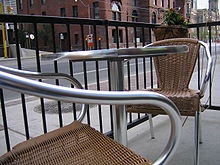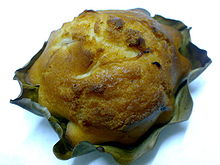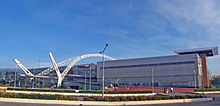- Mandaue
-
City of Mandaue
Dakbayan sa Mandaue— Highly Urbanized City — 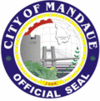
SealNickname(s): Furniture Capital of the Philippines; Industrial Capital of Southern Philippines Motto: "Mandaue ng Bililhon" Map of Cebu showing the location of Mandaue. Country Philippines Island Cebu Region Central Visayas, Region VII Class Highly Urbanized City Province Cebu Barrios or Barangays 27 Highest Point Casili Settled 12th-16th century Incorporated
- Town
1599- Municipality 1899 - City August 30, 1969 Government – Type City Legislative Council – Mayor Jonas Cortes – Vice-Mayor Glen Bercede Area – Total 34.87 km2 (13.5 sq mi) Population (March 2011) – Total 346,693 – Density 9,942.4/km2 (25,750.8/sq mi) Time zone PST (UTC+8) ZIP Code[1] 6014 Ecclesiastical Province Archdiocese of Cebu Episcopal Polity Patron Saint St. Joseph Diocesan Head Adelito Abella Website mandauecity.gov.ph The City of Mandaue is a city in the province of Cebu in the Philippines. It is one of the three urbanized cities in the island and forms a part of the Cebu Metropolitan area.[2] Mandaue City is located on the middle eastern coastal region of Cebu, bordering to its right-side are Mactan Island where Lapu-Lapu City is located. Mandaue is connected to Mactan Island via two bridges which includes the Mactan-Cebu Bridge and Marcelo Fernan Bridge [3] And is bounded south and the west by the Provincial Capital, Cebu City and north by Consolacion which is linked with Cansaga Bay Bridge. The city has an area of about 34.87 square kilometres and has a total population of about 346,693 people.[2]
Contents
History
A community was established in Mandaue by a flourishing group of Indonesian, Malayan and Chinese merchants in what was called the barangay. The Venetian chronicler Antonio Pigafetta wrote a settlement called Mandani existed in the area with a chieftain who was named Apo Noan[4] then a few decades later another ruler named Lam Busan, probably Lakan Busan .[5] Mandaue natives were forced into a town as decreed by the Spanish authorities. This may have started off as a mission village (which included present day Consolacion, Liloan and Poro) serving as a bulwark for the church in the northern Cebu and was managed by the Jesuit in 1638 then a century later by the Recollects.[6] The Philippine revolution in 1898 gave the town a new form of administration in accordance with the organic decree of the Central Revolutionary Government. The short lived revolution was overthrown by the American Troops and a battle nearly destroys the town on 1901 and killing Presidente Benito Ceniza.[7] Mandaue was Independent from being an American Commonwealth and a Japanese Garrison on July 4, 1946 along with the entire nation. Mandaue became a chartered city on June 21, 1969 by Mayor Demetrio Cortes Sr. The city was recognized as a HUC (Highly Urban City) on 1991.[8]
District
Mandaue City is part of the Sixth District of Cebu joined with the municipalities of Consolacion and Cordova. Although qualified for a lone district in 1991 this was neglected by lawmakers. Mandaue is under the province of Cebu but because it is a Highly Urbanized City it is not under authority to the provincial government and Mandaue is politically subdivided into 27 barangays. The barangay is further divided to a sitio.
Barangays
- Alang-alang
- Bakilid
- Banilad
- Basak
- Cabancalan
- Cambaro
- Canduman
- Casili
- Casuntingan
- Centro
- Cubacub
- Guizo
- Ibabao-Estancia
- Jagobiao
- Labogon
- Looc
- Maguikay
- Mantuyong
- Opao
- Pakna-an
- Pagsabungan
- Subangdaku
- Tabok
- Tawason
- Tingub
- Tipolo
- Umapad
.[9]
Area
The city has a total land area of 3,487 hectares or 34.87 square kilometres. Every square kilometre is inhabited by more or less 8,112 people. Land utilization is summarized as follows:
Category Land Area (hectares) Residential 872 hectares Commercial 242 hectares Industrial 1,695 hectares Institutional 60 hectares Parks 24 hectares Roads 120 hectares Agricultural 283 hectares The city is the 6th smallest government unit in terms of land area; among the Metro Cebu local government units the city is the second smallest next to the municipality of Cordova in the island of Mactan. The city's land area is only 4.5% of the total land area of Metro Cebu and less than 1% of the total land area of the Province of Cebu.
The on-going North Reclamation Project, now known as the North Special Administrative Zone, currently has about 180 hectares reclaimed land. Of the 180 hectares, about 36 hectares belong to the city. The existing mangrove area will be retained as a Marine habitat, part of the area's parks and open spaces.
It is one of the two (the other one being the municipality of Consolacion) local government units located within the mainland Metro Cebu where the elevation of land is less than 100 metres.
Many of the areas of the city are extremely flat. About 77.37% is within the 0-8% slope category. Barangays belonging to this region are Centro, Looc, South Special Administrative Zone, Cambaro, Opao, Umapad, Paknaan, Alang-alang, Tipolo, Ibabao, Guizo, Subangdaku, Mantuyong, Maguikay and Tabok. The greater portion of the city, comprising about 70%, is dominated by the Mandaue Clay Loam soil series. This is found in the 0-2% and 2-5% slope ranges. Faraon clay loam characterizes the rest of the land with slope range from 5-8% and up to 25-40%.[10]
Population
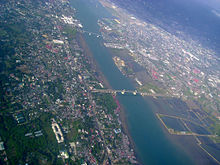 Metro Cebu, Mandaue in the eartern part and Lapulapu in the west
Metro Cebu, Mandaue in the eartern part and Lapulapu in the west
Population Census Census Pop. Rate 1970 58,579 — 1980 110,043 — 1990 180,288 5.1% 2000 259,728 — Est. 2011 346,693 33.48% Oldest accounts of Mandaue's population was written in Bosetta and Bravo's Diccionario between 1637 to 1638 was 11,034. During the first year of its township in 1899, Mandaue had 42 barrios and with a population of 21,086. When Mandaue was a second class municipality in 1964 and had a population of 33,811.[11] According to the March 22, 2011 Philippine census, Mandaue City has a population of about 346,693 people. This figure is up by 86,965 from 259,728 persons recorded in the May 2000 census. Mandaue has a significantly large population which is in and below the poverty line.[12]
Festivals
Mandaue Fiesta:Celebrated on May 8 in honor of the patron St. Joseph. There are a lot of events that occur in this feast like the Miss Mandaue, Mr. Mandaue, Inter-Barangay Sports Competition, Queen Prince and Prices Coronation or QPP, Rodeos, Mantawi Festival, Bailes, Fairs and many more. This is an evident reminder of the Philippines Hispanic influences.
Translacion: (Gathering of the Holy Family) which coincidentally the patrons of Cebu are the Santo Niño and Birhin sa Guadelupe, Saint Joseph in Mandaue City. This is celebrated every January when the three statues meet in The National Shrine of Saint Joseph often called the Translacion where a Fluvial Mass follows after. There are singing and dancing competitions and street dancing that happen during the Bibingkahan in honor of the Sto. Niño.
Comparsa sa Mandaue : A theater dance competition that showcases Mandaue's rich cultural heritage celebrated on August.
Mantawi Festival : Is an event where tribal dances are accompanied by different beats and is played by a brass instead of the usual drum and trumpet Mantawi Festival is on every May 7.[13]
Miss Mandaue: A beauty pageant, that searches for a young woman who will serve as an ambassadress of goodwill and represent the people of Mandaue City in various functions and gatherings in the community...[14]
Kabayo festival: The Kabayo festival is a horse racing event held annually in the second week of February.
Pasigarbo sa Sugbo: It is an event that is held annually in Mandaue City, Cebu International Convention Center every August 13 which shows Cebu's culture and different festivals, it is a fiesta of colorful costumes and elaborate props as dancers from 42 towns and cities from all over Cebu compete which ends with a grand fireworks display.
Sinulog sa Mandaue: Now defunct, Similar to the Sinulog of Cebu City but still celebrates the hubo of the Sto Nino under the Mandaue Sinulog Foundation.
Passion: A revival of the Passion and Death of Christ it was active in the 1973- 1975. Most of the spectators wore costumes to make it look realistic.
Infastructure
Mandaue City's road network is composed of a national highway which connects the city to its neighboring cities and municipalities, a national secondary road which traverses the City's metropolitan area. The total length of the city road network (paved and unpaved) and the four bridges, is about 133,676 kilometres, broken down into:
- National road - 13.1587 kilometres
- City road - 57.0954 kilometres
- Barangay road - 63.4219 kilometres
Road density is 3.83 kilometre per square kilometre of land. In terms of population, road density is about 0.52 kilometre per one thousand inhabitants.
Land transportation is being served by PUJ, Utility Vehicles, mini-buses, multi-cabs, tricycles, trisikads and for cargoes, trailers and vans. Sea transport of Mandaue is highly dependent on Port of Cebu and Cebu International Port, because of the city's proximity to these facilities. Likewise, air transport is through the Mactan International Airport has direct international flights to Hong Kong, Singapore, Japan, China, Palau, Malaysia, Taiwan, Qatar, South Korea and other key Philippine Cities, via the two Mandaue-Mactan bridges.[15]
Education
Schools in Mandaue City follow a system of 6 years for primary education and 4 years for secondary education.
Secondary Mandaue City Science High School • Mandaue City School for the Arts • Mandaue Christian School • Sacred Heart School – Ateneo de Cebu • Mandaue City Comprehensive National High School • 27 Public Schools • University of the Visayas Mandaue • Saint Louis School of MandaueChristian St. Joseph Academy • Colegio de la Inmaculada Concepcion • Mount Olives Christian School • Mandaue Christian School • Sacred Heart School – Ateneo de Cebu • Saint Louis School of MandaueInternational Schools Royal Oaks International School • Maternelle Filipino-French School • Sacred Heart School – Ateneo de Cebu • Singapore School CebuUniversities Colleges Mandaue City College • Benedicto College • ACLC Mandaue • AMA Computer Learning Center • STI CollegeCebu Doctors' University in Mandaue City.Sacred Heart School - Ateneo de CebuUniversity of Cebu Lapu-Lapu Mandaue.Economy
Major Products
- Aluminumware/Enamelware
- Animal Bone Processing
- Industrial Gases
- Lumber
- Marine Products
- Batteries
- Matches
- Beverages
- Milling
- Construction Materials
- Chemicals
- Nylons and Rope
- Coconut Crafts
- Packaging Products
- Commercial Plastics
- Concrete Products
- Poultry/livestock farms
- Rattan
- Cosmetics
- Drugs
- Electroplating
- School Supplies
- Fire Extinguishers
- Shellcrafts
- Floorwax
- Ceramics
- Foam Products Steel
- Galvanized Iron
- Food Processing
- Stonewares
- Garments
- Styrofoam
- Gas Cylinders
- Furniture
- Carrageenan
- Glass, Wrought Iron and Rattan
- Iced Products
.[9]
Cuisine
Mandaue has dining restaurants which caters to gourmets and international cuisines like Italian, Japanese, Korean, Mexican, Vietnamese, and Western cuisines. A variety of restaurants also serves meals of local cuisine.
Many famous Cebuano meals like the Lechon[16] or Inasal is a pride of Cebu being crowned as the best roasted pig in the world, it is eaten with Achara or pickled vegetables. The Sugba or Barbecue is either Isda(fish), Baboy (pork), Manok (chicken) or Baka (beef) is found in any joints in Mandaue eaten with the Puso a diamond shaped hangged rice covered in coco leaves. Kinilaw[17] is raw meat usually pork or fish drenched in vinegar and salt. The Buwad or dried seafood is very smelly but it is crunchy and chewy. There are some exotic meals you can find like the Dinugoan or pig's blood is a eaten like the soup. Barbecued Chicken feet are liked by many locals. Original cuisine in Mandaue includes the Bibingka[18] which is steamed rice cakes mixed with coconut and sometimes egg. Binangos a type of salted fish only found in Mandaue also includes the Tagaktak and the famous Masareal[citation needed]
Landmarks
Cemeteries
- Angelicum Gareden of Angels
- Cebu Memorial Park
- Cempark
- Manpark
- Mandaue Municipal Cemetery
- St Joseph's Cemetery
- Grosmar Memorial Park
Museums
- 856 G Gallery
- Luis Cabrera Ancestral House and Museum
- Mandaue City Public Library
- Quijano Museum
Parks
- City Plaza
- Pahara Park
- Mandaue Ecopark
- Garden Centre
Natural
- Monkey Caves
- Cansaga Bay
- Butuanon River
- Casili Hills
- Jagobiao Spring
- Cabancalan-Banilad Sinkholes
- Mahiga River
Sports
- Mandaue City Sports and Cultural Complex
- Greenlux Golf Range
- Mandaue Tennis Complex
- Portside Badminton Plaza
- Quick Points Badminton Club
- Aboitiz Sports Field
- San Roque Football Club
- Sacred Heart- Ateneo de Cebu Sports Complex
- Cebu Golf Academy
- AA Barbeque Restaurant & Golf Driving Range
Historical
- Bantayan Sa Hari
- National Shrine of Saint Joseph
- Mandaue Presidencia, City Hall
- Ouano Wharf
- Mandaue Salt Beds
- Eversley Childs Sanitarium
- Rizal-Bonifacio Memorial Library
- Bathan Press
- San Miguel Brewery
- Cebu International Convention Centre.[19]
Sister cities
 Bacău, Romania
Bacău, Romania Bacolod City, Philippines
Bacolod City, Philippines Baguio City, Philippines
Baguio City, Philippines Longview, Washington, USA
Longview, Washington, USA Butuan City, Philippines
Butuan City, Philippines Marikina, Philippines
Marikina, Philippines
References
- ^ "Zip codes in the Philippines". http://zip-codes.philsite.net/mandaue.htm. Retrieved 2009-03-29.
- ^ a b "The brilliance of Mandaue City". Mandaue City. cebu-philippines.net. http://www.cebu-philippines.net/mandaue.html.
- ^ "Mandaue–Mactan Bridges I and II". Mandaue City. STS designs.. http://www.everythingcebu.com/cebu-profile-basic-info/mandaue%E2%80%93mactan-bridges-i-and-ii/.
- ^ To America and Around the World: The Logs of Christopher Columbus and of .... Branden Publishing Co.. http://books.google.com.ph/books?id=eeY0ifyij6QC&pg=PA288&dq=mandani+aponoan#v=onepage&q=mandani%20aponoan&f=false.
- ^ Magellan's voyage: a narrative of the first circumnavigation. Yale University. http://books.google.com/books?id=RB4usvtAZrEC&pg=PA84&dq=lambuzzan+mandaui&cd=5#v=onepage&q=lambuzzan%20mandaui&f=false.
- ^ "Mandaue". admu.edu.ph. admu.edu.ph. http://www.admu.edu.ph/offices/mirlab/panublion/r7_mandaue.html.
- ^ The war against the Americans: resistance and collaboration in Cebu. Ateneo de Manila Press. http://books.google.com/books?id=5L9eOnRFEzgC&pg=PA140#v=onepage&q&f=false.
- ^ "History". Mandaue City. Mandaue city government. http://www.mandauecity.gov.ph/index.php?option=com_content&view=article&id=49&Itemid=57.
- ^ a b "Mandaue". Ngkhai. Ngkhai. http://www.ngkhai.com/pointcebu/facts/mandaue.htm.
- ^ "Land Use". Mandaue City. Mandaue city government. http://www.mandauecity.gov.ph/index.php?option=com_content&view=article&id=69&Itemid=81.
- ^ "MANDAUE CITY: POPULATION TO REACH HALF A MILLION IN 2011". Census. Philippine Census. http://www.census.gov.ph/data/pressrelease/2002/pr02160tx.html.
- ^ "Population". Mandaue City. Mandaue city government. http://www.mandauecity.gov.ph/index.php?option=com_content&view=article&id=69&Itemid=81.
- ^ "Mantawi... A Festival of History". Tourism. The City of Mandaue. http://www.mandauecity.gov.ph/index.php?option=com_content&view=article&id=70&Itemid=83. Retrieved 2008-04-22.
- ^ "Miss Mandaue". Fiesta Committee. The City of Mandaue. http://www.missmandaue.com/index.html.
- ^ vodpod.com/watch/3115556-team-mandaue-infrastructure
- ^ "lechon". lechoncebu.com. http://www.lechoncebu.com/.. http://www.lechoncebu.com/.
- ^ "Sugba Tuwa Kilaw". Travelocity.com. Travelocity.com.. http://www.igougo.com/journal-j48817-Cebu-Four-day_CebuMactan_trip.html#ReviewID:1186427.
- ^ "Mandaue's Native Bibingka". cebudailynews. globalnation.inquirer.net. http://globalnation.inquirer.net/cebudailynews/enterprise/view/20090119-184239/Mayols-continue-to-make-famous-bibingka.
- ^ "Other Landmarks". Tourism. The City of Mandaue. http://www.mandauecity.gov.ph/festival/otherlandmarks.htm. Retrieved 2008-04-22.
External links
- The Official Website of the City of Mandaue
- The Official Website of the Philippine Department of Education
- The Official Website of the Taga Mandaue
- Philippine Standard Geographic Code
- 2000 Philippine Census Information
- 2007 Philippine Census Information
Coordinates: 10°20′0″N 123°56′0″E / 10.333333°N 123.933333°E
Mandaue City Barangays: Alang-alang · Bakilid · Banilad · Basak · Centro · Cabancalan · Cambaro · Canduman · Casili · Cubacub · Casuntingan · Guizo · Ibabao-Estancia · Jagobiao · Labogon · Looc · Maguikay · Mantuyong · Opao · Pakna-an · Pagsabungan · Subangdaku · Tabok · Tawason · Tingub
· Tipolo · UmapadCities Municipalities  Cities of the Philippines
Cities of the PhilippinesHighly-urbanized Cities Angeles · Bacolod · Baguio · Butuan · Cagayan de Oro · Caloocan · Cebu · Davao · General Santos · Iligan · Iloilo · Lapu-Lapu · Las Piñas · Lucena · Makati · Malabon · Mandaluyong · Mandaue · Manila · Marikina · Muntinlupa · Navotas · Olongapo · Parañaque · Pasay · Pasig · Puerto Princesa · Quezon City · San Juan · Tacloban · Taguig · Zamboanga
Independent
Component CitiesComponent Cities Alaminos · Antipolo · Bago · Bais · Balanga · Batangas · Batac · Bayawan · Baybay · Bayugan · Biñan · Bislig · Bogo · Borongan · Cabadbaran · Cabanatuan · Cadiz · Calamba · Calapan · Calbayog · Candon · Canlaon · Carcar · Catbalogan · Cauayan · Cavite · Danao · Dapitan · Dasmariñas · Digos · Dipolog · Dumaguete · El Salvador · Escalante · Gapan · Gingoog · Guihulngan · Himamaylan · Iriga · Isabela · Kabankalan · Kidapawan · Koronadal · La Carlota · Lamitan · Laoag · Legazpi · Ligao · Lipa · Maasin · Malaybalay · Malolos · Marawi · Masbate · Mati · Meycauayan · Muñoz · Naga, Cebu · Oroquieta · Ozamiz · Pagadian · Palayan · Panabo · Passi · Roxas · Sagay · Samal · San Carlos, Negros Occidental · San Carlos, Pangasinan · San Fernando, La Union · San Fernando, Pampanga · San Jose · San Jose del Monte · San Pablo · Santa Rosa · Silay · Sipalay · Sorsogon · Surigao · Tabaco · Tabuk · Tacurong · Tagaytay · Tagbilaran · Tagum · Talisay, Cebu · Talisay, Negros Occidental · Tanauan · Tandag · Tangub · Tanjay · Tarlac · Tayabas · Toledo · Trece Martires · Tuguegarao · Urdaneta · Valencia · Victorias · Vigan
Component local government units of Cebu Municipalities - Alcantara
- Alcoy
- Alegria
- Aloguinsan
- Argao
- Asturias
- Badian
- Balamban
- Bantayan
- Barili
- Boljoon
- Borbon
- Carmen
- Catmon
- Compostela
- Consolacion
- Cordova
- Daanbantayan
- Dalaguete
- Dumanjug
- Ginatilan
- Liloan
- Madridejos
- Malabuyoc
- Medellin
- Minglanilla
- Moalboal
- Oslob
- Pilar
- Pinamungahan
- Poro
- Ronda
- Samboan
- San Fernando
- San Francisco
- San Remigio
- Santa Fe
- Santander
- Sibonga
- Sogod
- Tabogon
- Tabuelan
- Tuburan
- Tudela
Component cities Highly urbanized cities - Cebu
- Lapu-Lapu
- Mandaue
Categories:- High schools in Mandaue
- Mandaue City
- Metro Cebu
- Populated coastal places in the Philippines
Wikimedia Foundation. 2010.


